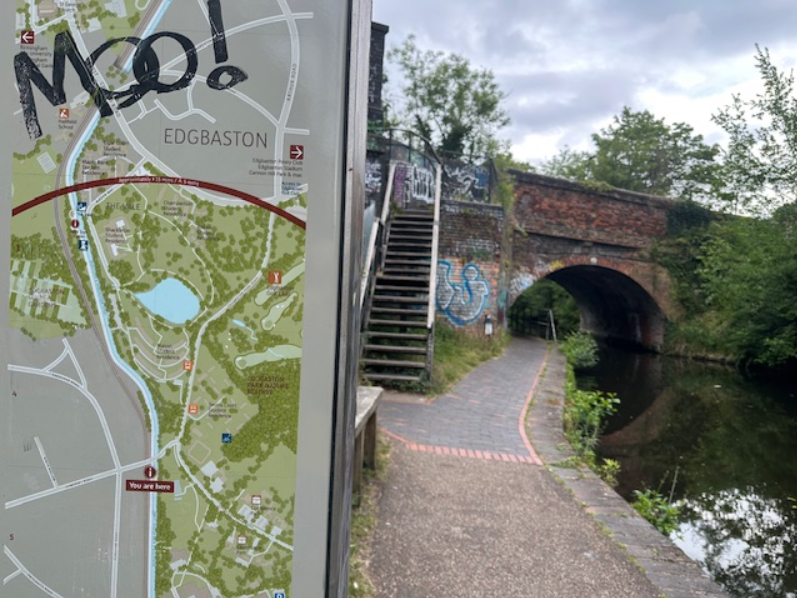
I regularly run along the canals of Birmingham, but I’ve never run through Moor Pool or Harborne. As someone passionate about both heritage and canals and fortunate enough to work in Moor Pool and live in Bournville, I had a thought: why not connect two of Britain’s finest examples of garden suburb planning… by running between them!
So here it is! A heritage run from Bournville to Moor Pool, linking two visionary communities designed for healthier, greener, and more community living. A journey through Birmingham’s radical social planning history, fuelled by chocolate, canals and industry. I expect the distance to be around 20-21km with the 5km taking place within the Moor Pool Estate as part of the Moor Pool 5k Summer Challenge.
The run begins at Bournville Station, which is technically in Stirchley. Just a few hundred metres in, you can inhale the scent of chocolate: Cadbury’s factory to the left, just over the Bournville Lane canal bridge, where cocoa once arrived by barge and goods departed by rail. Further on overhead is the Cadbury railway bridge, part of the original private rail network.
This is Bournville: where Ebenezer Howard, pioneer of the garden city movement, held the first Garden City Association conference in 1901 – an event that inspired John Sutton Nettlefold to later build Moor Pool.
From here, the canal towpath stretches from Bournville to Selly Oak and beyond. On the right is Grade II listed Selly Oak Electricity Substation built by Moor Pool’s architects Martin & Martin in 1890. This section of the Worcester & Birmingham Canal once carried timber, coal and bricks – raw materials crucial to the construction of both Bournville and Moor Pool.
Near Selly Oak Junction, the route passes the former site of Goodman’s Yard, a major timber merchant that supplied wood for the early phases of Moor Pool. This junction also once connected to the now-defunct Dudley No. 2 Canal, which led to brickworks in California and Halesowen (Smart Brickworks and William Ward’s Brickworks). Those very bricks made helped build both garden suburbs, carried by canal along Birmingham’s waterways.
The canal route passes through the University of Birmingham – Old Joe clock tower rises to the right, named after Joseph Chamberlain, a visionary reformer like John Sutton Nettlefold and both connected by politics, family and Unitarianism.
Exiting the canal at Somerset Road and on to Winterbourne House, an Arts and Crafts house, once home to John Sutton Nettlefold himself. Inspired by Cadbury’s Bournville model, he set out to create Moor Pool as a place where working families could live in a true village community, surrounded by trees, gardens and communal facilities.
From Winterbourne House, it’s a short descent to Farquhar Road, lined with Arts & Crafts-style homes – one designed by, and home to, Frederick William Martin, who built Moor Pool.
Running through Harborne Village, the route passes the old Harborne railway line, now the leafy Harborne Walkway, and then on toward Margaret Grove and Moor Pool Avenue: the entrance to the Moor Pool Estate. It was here, in 1907, that Margaret Nettlefold cut the first sod in 1907, beginning her husband’s great social experiment.
Running up to the top of Carless Avenue where the final house was completed by 1912, only covers about 1km end-to-end. So to clock the full 5k within the Estate, the run loops along its lanes several times. This includes several laps of The Circle, where 10 years ago locals laid a double ring of 20p coins to raise funds for the Estate’s community facilities.
It seems fitting to run several laps of The Circle as the heart of the Estate, including Moor Pool Hall, along with the original shops and Estate Office, all opened in 1910. These continue to be the heart of the community today.
On the return leg, the run retraces part of my route, but follows Harborne Lane, alongside Selly Oak park and the long-defunct Lapal canal line. Once part of the Dudley No. 2 Canal, the Lapal canal line connected the Midlands’ canal network with brickworks that literally laid the foundations of both Moor Pool and Bournville.
This run is a journey through Birmingham’s social and architectural history. Both Bournville and Moor Pool were born of the same desire to build better houses, environment and community in the face of rapid industrialisation.
Sponsor me running through Birmingham’s garden suburb history!
And here’s the plan of the route if you want to follow in the footsteps, lace up and give it a go!
Click here for details of how to register for the Moor Pool 5k Summer Challenge. Registration is open until Monday 4th August.
Barbara Nomikos, Moor Pool Hall Manager, July 2025
Moor Pool Hall
37 The Circle, Harborne,
Birmingham, B17 9DY
Registered Charity Number: 1148252
© 2025 All rights reserved | Website by Citrus Frog